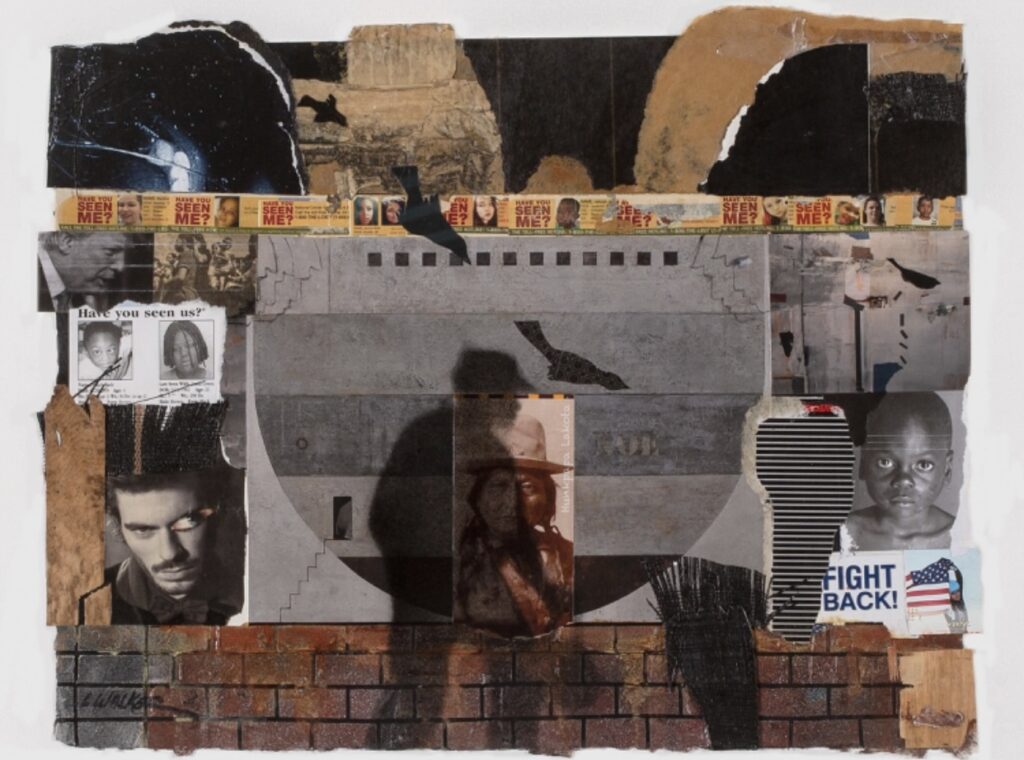Larry Walker’s Enigmatic Messenger, at Mason Fine Art through August 10, is the prototype of an exhibition that the gallery intends to tour to at least two museums. It’s a singularly moving survey of aspects of Walker’s work, most notably the 40-year trajectory of the Wall Series.
This series is inspired by the inadvertent communications created by the juxtaposition of layers of torn-off posters on urban walls, similar to those that inspired this project when Walker revisited his childhood neighborhood in Harlem in 1980.

The works incorporate many implicit messages, most of them oblique, sometimes to the point of being, as the exhibition title implies, an enigma. Sometimes the titles imply a clearly expressed concern with social problems, as in Cheap Labor Happens (2005) or Cross Cultural Dialogue II: Victim Wall (2003).
Others, such as 1995’s Blue Angel: Detach & Return, are more metaphoric. Some are directly poignant, even with little additional knowledge, such as Dream Catcher for Covid-19: Elegy for David, a 2020 mixed media work that is almost certainly a memorial to the famed Black critic and artist David Driskell.
A recurrent motif in the Wall Series is the shadow of an elderly man wearing a cap or a hat and leaning on a cane. He is occasionally replaced or accompanied by the shadow of an elderly woman supporting herself with a walking stick. When the figure first appeared, some 20 years into the series, it was easy to assume it was an autobiographical reference, but Walker has made clear he intends the figure to symbolize far more than his own aging.
The shadow figure appears by itself, without the wall as background, in several smaller works on paper, most recently in a poignant 2022 lithograph titled Ghost. This seemingly disembodied iteration of the theme is repeated with a poster-wall background in Ghosts Shadow – Sleepless Wall, also from 2022.

Although the contents and titles of the works often suggest that they are a puzzle or a riddle to be deciphered, as in Have You Seen Us…? (Immigration Plan #2018), 2018, they are better understood as a contemplative presentation of irresolvable difficulties or, in some cases, of uninterpretable mysteries.
As Walker’s internationally famous artist daughter Kara Walker pointed out, these works are also full of spirit figures and spirit voices, as in LeFeu (Spirit Voices), 2008, and Marginal Passage: Spirit Voices, 2009.
If Walker’s meanings seem elusive, it eventually becomes evident that they are meant to be. These are works of art, not allegories, although they sometimes approach that state in which each thing represents an underlying concept or bigger situation.
Even in their most emphatically and unmistakably political moments, these works refuse to be boxed in.
::
Dr. Jerry Cullum’s reviews and essays have appeared in Art Papers magazine, Raw Vision, Art in America, ARTnews, International Review of African American Art and many other popular and scholarly journals. In 2020, he was awarded the Rabkin Prize for his outstanding contribution to arts journalism.

